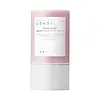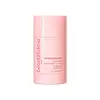What's inside
What's inside
 Key Ingredients
Key Ingredients

 Benefits
Benefits

 Concerns
Concerns

 Ingredients Side-by-side
Ingredients Side-by-side

Water
Skin ConditioningKaolin 8%
AbrasiveDipropylene Glycol
HumectantGlycerin
HumectantCI 77891
Cosmetic ColorantButylene Glycol
HumectantSodium Stearate
CleansingCentella Asiatica Extract 4.9%
Cleansing1,2-Hexanediol
Skin ConditioningPhaseolus Angularis Seed Powder
Aloe Barbadensis Leaf Extract
EmollientCetearyl Olivate
Propanediol
SolventSorbitan Olivate
EmulsifyingDimethicone
EmollientCI 77491
Cosmetic ColorantEthylhexylglycerin
Skin ConditioningSodium Phytate
Bentonite
AbsorbentIllite
AbrasiveMineral Salts
Skin ConditioningMontmorillonite
AbsorbentCalamine
AbsorbentWater, Kaolin 8%, Dipropylene Glycol, Glycerin, CI 77891, Butylene Glycol, Sodium Stearate, Centella Asiatica Extract 4.9%, 1,2-Hexanediol, Phaseolus Angularis Seed Powder, Aloe Barbadensis Leaf Extract, Cetearyl Olivate, Propanediol, Sorbitan Olivate, Dimethicone, CI 77491, Ethylhexylglycerin, Sodium Phytate, Bentonite, Illite, Mineral Salts, Montmorillonite, Calamine
Water
Skin ConditioningKaolin
AbrasiveVolcanic Soil
Skin ConditioningButylene Glycol
HumectantGlycerin
HumectantTitanium Dioxide
Cosmetic ColorantSodium Palmitate
CleansingMica
Cosmetic ColorantCetearyl Olivate
Sorbitan Olivate
EmulsifyingBeta-Glucan
Skin ConditioningNiacinamide
SmoothingPunica Granatum Fruit Extract
AntioxidantPhenoxyethanol
PreservativeCI 77491
Cosmetic ColorantCI 45380
Cosmetic ColorantSaccharide Isomerate
HumectantHydroxypropyl Cyclodextrin
MaskingPistacia Lentiscus Gum
MaskingMyrtus Communis Leaf Extract
PerfumingSaccharomyces Ferment Lysate Filtrate
Skin ConditioningHydrolyzed Algin
Caprylyl Glycol
EmollientRhamnose
HumectantMenthyl Lactate
MaskingPEG-40 Hydrogenated Castor Oil
EmulsifyingAroma
Potassium Sorbate
PreservativeCitric Acid
BufferingSodium Benzoate
MaskingEthylhexylglycerin
Skin ConditioningWater, Kaolin, Volcanic Soil, Butylene Glycol, Glycerin, Titanium Dioxide, Sodium Palmitate, Mica, Cetearyl Olivate, Sorbitan Olivate, Beta-Glucan, Niacinamide, Punica Granatum Fruit Extract, Phenoxyethanol, CI 77491, CI 45380, Saccharide Isomerate, Hydroxypropyl Cyclodextrin, Pistacia Lentiscus Gum, Myrtus Communis Leaf Extract, Saccharomyces Ferment Lysate Filtrate, Hydrolyzed Algin, Caprylyl Glycol, Rhamnose, Menthyl Lactate, PEG-40 Hydrogenated Castor Oil, Aroma, Potassium Sorbate, Citric Acid, Sodium Benzoate, Ethylhexylglycerin
 Reviews
Reviews

Ingredients Explained
These ingredients are found in both products.
Ingredients higher up in an ingredient list are typically present in a larger amount.
Butylene Glycol (or BG) is used within cosmetic products for a few different reasons:
Overall, Butylene Glycol is a safe and well-rounded ingredient that works well with other ingredients.
Though this ingredient works well with most skin types, some people with sensitive skin may experience a reaction such as allergic rashes, closed comedones, or itchiness.
Learn more about Butylene GlycolCetearyl Olivate is an emulsifier and texture enhancer. It is derived from the fatty acids of olive oil and Cetearyl alcohol, and is biodegradable.
As an emulsifier, it is used to prevent oils and waters from separating. It can also
Manufacturers use the name Olivem 1000. This ingredient has been found to preserve the natural microbiome of skin. Having a healthy microbiome helps keep our skin healthy and protects against harmful bacteria. This ingredient is grouped with Sorbitan Olivate under the name Olivem 1000.
Learn more about Cetearyl OlivateCi 77491 is also hydrated iron III oxide. It's sole purpose is to give a red/pink hue to products.
Iron III oxides are classified as inorganic chemicals for coloring.
Synthetically created Ci 77491 is considered safer than those naturally found. This is because the synthetically created version may contain less impurities. Iron oxides are generally non-toxic and non-allergenic.
Learn more about CI 77491Ethylhexylglycerin (we can't pronounce this either) is commonly used as a preservative and skin softener. It is derived from glyceryl.
You might see Ethylhexylglycerin often paired with other preservatives such as phenoxyethanol. Ethylhexylglycerin has been found to increase the effectiveness of these other preservatives.
Glycerin is already naturally found in your skin. It helps moisturize and protect your skin.
A study from 2016 found glycerin to be more effective as a humectant than AHAs and hyaluronic acid.
As a humectant, it helps the skin stay hydrated by pulling moisture to your skin. The low molecular weight of glycerin allows it to pull moisture into the deeper layers of your skin.
Hydrated skin improves your skin barrier; Your skin barrier helps protect against irritants and bacteria.
Glycerin has also been found to have antimicrobial and antiviral properties. Due to these properties, glycerin is often used in wound and burn treatments.
In cosmetics, glycerin is usually derived from plants such as soybean or palm. However, it can also be sourced from animals, such as tallow or animal fat.
This ingredient is organic, colorless, odorless, and non-toxic.
Glycerin is the name for this ingredient in American English. British English uses Glycerol/Glycerine.
Learn more about GlycerinKaolin is a clay. It is used for oil control and to help minimize pores. Like other clays, kaolin has the ability to absorb excess sebum or oil. This can help clean out pores and mattify the skin.
Some types of kaolin may have exfoliating properties. When water is added to kaolin, it becomes a paste with small abrasive particles.
Most kaolin is a white color, but may be pink/orange/red depending on where it comes from.
The name 'kaolin' comes from a Chinese village named 'Gaoling'. Kaolin clay comes from rocks rich in kaolinite. Kaolinite, the mineral, has a silicate layered structure. Kaolinite is formed from chemical weathering of aluminum siilicate minerals.
Besides skincare, kaolin is commonly used to make glossy paper, in ceramics, toothpaste, and as medicine to soothe stomach issues.
Learn more about KaolinSorbitan Olivate is created from the fatty acids in olive oil and sorbitol.
This ingredient is an oil in water emulsifier. It helps stabilize a product by preventing oils and waters from separating. Sorbitan Olivate also helps hydrate the skin.
Manufacturers sell sorbitan olivate under the name OliveM 1000. OliveM 1000 a multifunctional ingredient. It is self-emulsifying. According to a manufacturer, OliveM 1000 does not disrupt natural skin biome.
Due to its olive oil base, this ingredient may not be fungal-acne safe.
Learn more about Sorbitan OlivateWater. It's the most common cosmetic ingredient of all. You'll usually see it at the top of ingredient lists, meaning that it makes up the largest part of the product.
So why is it so popular? Water most often acts as a solvent - this means that it helps dissolve other ingredients into the formulation.
You'll also recognize water as that liquid we all need to stay alive. If you see this, drink a glass of water. Stay hydrated!
Learn more about Water